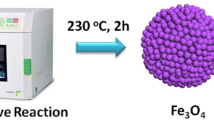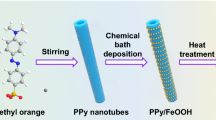Abstract
Despite the high theoretical capacity of iron-based anode materials, they still perform poorly in electrical conductivity and volume expansion during the charge/discharge process, which can reduce battery life and cause deterioration in cycle performance. In the present study, iron-based metal–organic frameworks are synthesized through a simple co-precipitation method, and then heat-treated as a self-sacrificing template to obtain carbon-coated Fe3O4 of a porous ortho-octahedral structure. As revealed by electrochemical performance studies, this material maintains a high specific capacity, showing a reversible capacity of 1063 mAh/g and 896 mAh/g after 300 cycles at a current density of 0.5 A/g and 1 A/g. By analyzing the functional mechanism of surface carbon coating, it is demonstrated that the fast ion migration and high electrical conductivity required for fast charging and discharging are ensured by the octahedral and hierarchical void structure of the carbon framework. This study thus provides a reference for the design of high-performance electrode materials.
Graphical Abstract







Similar content being viewed by others
References
K.K. Jena, A. AlFantazi, and A.T. Mayyas, Comprehensive review on concept and recycling evolution of lithium-ion batteries. Energy Fuels 35(22), 18257 (2021).
Y.Y. Chen, W.Q. Du, B.X. Dou, J.H. Chen, and L. Hu, Metal-organic frameworks and their derivatives as electrode materials for Li-ion batteries: a mini review. CrystEngComm 24, 2729 (2022).
L. Ding, M. Zeng, H. Wang, and X.B. Jiang, Synthesis of MIL-101-derived bimetal–organic framework and applications for lithium-ion batteries. J. Mater. Sci. Mater. Electron. 32, 1778 (2021).
Y. Li, Y. Xu, W. Yang, W. Shen, H. Xue, and H. Pang, MOF-derived metal oxide composites for advanced electrochemical energy storage. Small 14(25), 1704435 (2018).
H. Wang, Y. Bai, X.B. Jiang, and M. Zeng, Bimetal-organic framework derived from ZIF-67 as anodes for high performance lithium-ion batteries. Appl. Surf. Sci. 546, 149119 (2021).
X.L. Xu, S. Cai, X.D. Song, Y.M. Zhao, G.W. Zhou, and Y. Liu, A mini review on the excellent nanostructures in electrochemical energy storage and conversion. NANO 17, 2230002 (2022).
D. Jiang, M. Chen, H. Wang, G.M. Zeng, D.L. Huang, M. Cheng, Y. Liu, W.J. Xue, and Z.W. Wang, The application of different typological and structural MOFs-based materials for the dyes adsorption. Coord. Chem. Rev. 380, 471 (2019).
J.W. Shin, M. Kim, J. Cirera, S. Chen, G.J. Halder, T.A. Yersak, and F. Paesani, MIL-101(Fe) as a lithium-ion battery electrode material: a relaxation and intercalation mechanism during lithium insertion. J. Mater. Chem. A 3, 4738 (2015).
J.Y. Ma, X.T. Guo, Y. Yan, H.G. Xue, and H. Pang, FeOx-based materials for electrochemical energy storage. Adv. Mater. 5, 1700986 (2018).
Y. Huang, Y.W. Li, R.S. Huang, and J.H. Yao, Ternary Fe2O3/Fe3O4/FeCO3 composite as a high-performance anode material for Lithium-ion batteries. J. Phys. Chem. C 123(20), 12614 (2019).
F.X. Ma, H. Hu, H.B. Wu, C.Y. Xu, Z.C. Xu, L. Zhen, and X.W. Lou, Formation of uniform Fe3O4 hollow spheres organized by ultrathin nanosheets and their excellent Lithium storage properties. Adv. Mater. 27, 4097 (2015).
H. Zhu, Q.Y. Wei, S.J. Yu, P.C. Guo, J.K. Li, and Y.X. Wang, Synthesis of hollow nanostructures based on Iron oxides and their applications in lithium-ion batteries. J. Electron. Mater. 51, 4207 (2022).
Y. Liang and W.L. Lu, Gamma-irradiation synthesis of Fe3O4/rGO nanocomposites as lithium-ion battery anodes. J. Mater. Sci. Mater. Electron. 31, 17075 (2020).
S.H. Choi and Y.C. Kang, Fe3O4-decorated hollow graphene balls prepared by spray pyrolysis process for ultrafast and long cycle-life lithium-ion batteries. Carbon 79, 58–66 (2014).
Y.F. Li, Y.Y. Fu, S.H. Chen, Z.Z. Huang, L. Wang, and Y.H. Song, Porous Fe2O3/Fe3O4@Carbon octahedron arrayed on three-dimensional graphene foam for lithium-ion battery. Compos. Part B Eng. 171, 130–137 (2019).
Q.T. Zhang, Y. Meng, M. Li, and X.M. Wang, Thiophene containing conjugated microporous polymers derived sulfur-enriched porous carbon supported Fe3O4 nanoparticles with superior lithium storage properties. J. Mater. Sci. Mater. Electron. 30, 1425 (2019).
X.B. Jiang, M.Y. Shao, K. Li, L. Ding, and M. Zeng, Facile synthesis and lithium storage mechanism study of directly usable tin-based metal organic framework. J. Electroanal. Chem. 912, 116268 (2022).
L. Miao, D.Z. Zhu, Y.H. Zhao, M.X. Liu, H. Duan, W. Xiong, Q.J. Zhu, L.C. Li, Y.K. Lv, and L.H. Gan, Design of carbon materials with ultramicro-, supermicro- and mesopores using solvent-and self-template strategy for supercapacitors. Micropor. Mesopor. Mat. 253, 1–9 (2017).
M. Barjasteh, M. Vossoughi, M. Bagherzadeh, and K.P. Bagheri, Green synthesis of PEG-coated MIL-100(Fe) for controlled release of dacarbazine and its anticancer potential against human melanoma cells. Int. J. Pharmaceut. 618, 121647 (2022).
Y. Bai, M. Zeng, X. Wu, Y.Q. Zhang, J.W. Wen, and J. Li, Three-dimensional cage-like Si@ZIF-67 core–shell composites for high-performance lithium storage. Appl. Surf. Sci. 510, 145477 (2020).
K. Wang, M.M. Chen, Z.H. He, L.A. Huang, S.S. Zhu, S.E. Pei, H.B. Shao, and J.M. Wang, Hierarchical Fe3O4@C nanospheres derived from Fe2O3/MIL-100 (Fe) with superior high-rate lithium storage performance. J. Alloy. Compd. 755, 154–162 (2018).
X. Wu, Y. Bai, M. Zeng, and J. Li, Novel secondary assembled porous MgCo2O4 for high-performance lithium storage. Mater. Lett. 240, 225 (2019).
L. Ding, X.Y. Zheng, R.C. Qin, P.Y. Guo, X.B. Jiang, and M. Zeng, Facile construction of C and TiO2 surface coating to improve the cycling stability of NiMn2O4 composite electrode materials. Mater. Lett. 323, 132561 (2022).
K.B. Zhang, X.B. Jiang, M. Zeng, and B. Jing, Hydrothermal synthesis of three-dimensional hydrangea-like MoSe2@N-doped carbon anode material for high performance lithium ion batteries. J. Electroanal. Chem. 879, 114818 (2020).
H. Zhao, L. Sheng, L. Wang, H. Xu, and X.M. He, The opportunity of metal organic frameworks and covalent organic frameworks in lithium (ion) batteries and fuel cells. Energy Storage Mater. 33, 360 (2020).
Acknowledgments
This work was supported by the Sichuan Science and Technology Program (No. 2022NSFSC0334).
Author information
Authors and Affiliations
Corresponding author
Ethics declarations
Conflict of interest
All the authors declare that they have no possible conflicts of interest.
Ethical Approval
All research was conducted in compliance with ethical standards.
Additional information
Publisher's Note
Springer Nature remains neutral with regard to jurisdictional claims in published maps and institutional affiliations.
Rights and permissions
Springer Nature or its licensor (e.g. a society or other partner) holds exclusive rights to this article under a publishing agreement with the author(s) or other rightsholder(s); author self-archiving of the accepted manuscript version of this article is solely governed by the terms of such publishing agreement and applicable law.
About this article
Cite this article
Li, K., Qin, R., Xiong, Y. et al. MOF-Derived Octahedral-Shaped Fe3O4@C Composites for Lithium Storage. J. Electron. Mater. 52, 3311–3320 (2023). https://doi.org/10.1007/s11664-023-10301-4
Received:
Accepted:
Published:
Issue Date:
DOI: https://doi.org/10.1007/s11664-023-10301-4




